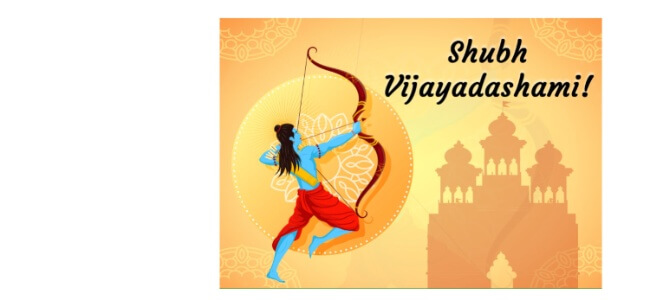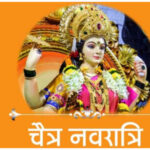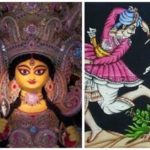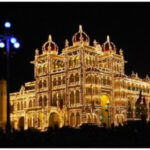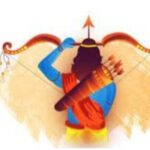India is a land of diverse festivals, each celebrated with fervour and enthusiasm, but few rival the grandeur and significance of Dussehra. This auspicious occasion is observed with great zeal across the country, marking the victory of good over evil. In this blog post, we delve into the profound significance of Dussehra, the intricacies of Navaratri leading up to it, and why it holds a special place in the hearts of millions of Indians.
Table of Contents
Celebration of Dussehra in India

Dussehra, also known as Vijayadashami, is a widely celebrated festival in India. It falls on the tenth day of Navaratri, a nine-night festival dedicated to the worship of Goddess Durga. Dussehra signifies the triumph of Lord Rama over the demon king Ravana, as depicted in the epic Ramayana. On this day, the effigies of Ravana, his brothers, and the ten-headed demon king himself are set ablaze in open fields, symbolizing the victory of good over evil. The festival is marked with grand processions, music, and vibrant celebrations.
Navaratri and Dussehra Festival Celebration in India
The festivities leading up to Dussehra are as significant as the day itself. Navaratri, which translates to “nine nights,” is celebrated with immense fervour. During these nine nights, devotees engage in prayer, fasting, and cultural performances. Each day of Navaratri is dedicated to a different form of Goddess Durga. The festival symbolizes the divine Shakti aspect and the victory of good over evil, with the last day culminating in the celebration of Dussehra.
Throughout Navaratri, homes are adorned with vibrant decorations, and people dress in traditional attire. Dance forms like Garba and Dandiya Raas are an integral part of the celebration, and these energetic dances are performed in large gatherings. The atmosphere is filled with joy, devotion, and a sense of community as people come together to honour the goddess and celebrate life.
The tenth day of Navaratri is Dussehra, which holds a special place in the hearts of millions of Indians. It is a day of immense significance, as it commemorates the epic battle between Lord Rama and the demon king Ravana, an event narrated in the ancient Indian epic, the Ramayana. The victory of Lord Rama, who is revered as the embodiment of virtue and righteousness, over the evil Ravana symbolizes the ultimate victory of good over evil.
Significance of Dussehra
- Triumph of Good Over Evil: Dussehra stands as a profound reminder of the eternal battle between good and evil. It conveys the message that no matter how powerful the forces of darkness may seem, righteousness and goodness will eventually prevail.
- Victory of Lord Rama: Dussehra primarily commemorates Lord Rama’s victory over Ravana. It is a celebration of Rama’s virtuous qualities, his adherence to dharma (righteousness), and his unwavering devotion to truth.
- Renewal of Virtue: It serves as an opportunity for individuals to reflect on their own lives and make a conscious effort to strengthen their virtues, conquer their inner demons, and uphold moral values.
- Cultural Unity: Dussehra brings people of various communities, languages, and regions together. It unites the diverse fabric of India in a common celebration of the triumph of good.
- Festival of Knowledge: Dussehra is also celebrated as Ayudha Puja in the southern part of India, where tools, instruments, and vehicles are worshipped. This celebration is a way of acknowledging the significance of knowledge and skills in our lives.
- Respect for Women: It honours the Shakti aspect through the worship of Goddess Durga during Navaratri. It is a celebration of the power, strength, and wisdom associated with women.
- Harvest Festival: In some regions, Dussehra coincides with the harvest season, making it a time to express gratitude for the bounties of nature and the hard work of farmers.
- Time of New Beginnings: Dussehra marks the end of an auspicious period and the beginning of a new one. Many people start new ventures, buy new possessions, and make important life decisions during this time.
- Reinforcement of Ethics: The stories and legends associated with Dussehra inspire people to adhere to ethical conduct and maintain moral integrity in their lives.
- Cultural Heritage: The festival preserves and promotes the rich cultural heritage of India, passing down stories, traditions, and values from one generation to the next.
Why Do We Celebrate Dussehra? | Reason For Celebrating Dussehra In India
Dussehra is celebrated for a multitude of reasons, each contributing to its rich cultural significance:
- Mythological Significance: As mentioned earlier, Dussehra commemorates Lord Rama’s victory over the demon king Ravana. It reinforces the belief in the power of righteousness and the inevitability of good triumphing over evil.
- Spiritual Renewal: It is a time for spiritual introspection and renewal. People engage in prayers and seek blessings from the divine, hoping to cleanse themselves of impurities and gain inner strength.
- Festive Unity: Dussehra is a time when communities come together to celebrate the victory of good over evil, transcending barriers of caste, creed, and culture.
- Ayudha Puja: The practice of Ayudha Puja, where tools, vehicles, and instruments are worshipped, highlights the importance of knowledge and skills in our daily lives. It’s a way of acknowledging that the tools we use for our livelihood are integral to our existence.
- Honouring the Divine Shakti: The worship of Goddess Durga during Navaratri is an ode to divine feminine energy. It symbolizes the empowerment of women and their importance in our society.
- Harvest Festival: In agrarian communities, Dussehra is a time to celebrate the harvest and express gratitude for the abundance provided by the land. It also marks the beginning of the sowing season.
- Cultural Preservation: Dussehra plays a vital role in preserving India’s cultural heritage by passing down stories, traditions, and values from one generation to the next.
- Symbolism: The burning of Ravana effigies signifies the destruction of one’s inner demons and negative qualities. It’s a call for self-improvement and embracing positivity.
- New Beginnings: With the belief that the divine is on their side, many people start new ventures, make major life decisions, or buy new possessions during this auspicious time.
- Ethical Compass: The stories of Dussehra serve as a moral compass, reminding individuals of the importance of ethical conduct and the consequences of straying from the path of righteousness.
Why Dussehra is also called Vijayadashami
Dussehra is also known as Vijayadashami, where “Vijaya” means victory and “Dashami” refers to the tenth day. This alternate name signifies the victory of Lord Rama over Ravana on the tenth day of the battle. It serves as a constant reminder that the triumph of good over evil is an eventuality. Vijayadashami is a term that encapsulates the core essence of the festival – the celebration of victory, righteousness, and the ultimate defeat of malevolence.
Mysore Dasara Celebration
One of the most famous Dussehra celebrations in India takes place in Mysore, Karnataka. Mysore Dasara festival is known for its grandeur and splendour. The tradition of celebrating Dasara in Mysore dates back to the Wadiyar dynasty, and it continues to be a cultural extravaganza.
The Mysore Dasara celebrations last for ten days, coinciding with the Navaratri festival. The main attraction is the grand procession that features an elaborately decorated idol of Goddess Chamundeshwari, who is the presiding deity of Mysore. The idol is placed on a golden throne, and it is paraded through the streets of the city, accompanied by music, dance, and an entourage of caparisoned elephants, soldiers, and folk artists.
The Mysore Palace, an architectural marvel, is illuminated with thousands of bulbs and looks resplendent during the festivities. Cultural programs, exhibitions, and sports events are organized as part of the celebrations. The grand finale of Mysore Dasara is the torchlight parade on the final day, where the effigies of Ravana, Meghnad, and Kumbhakarna are set ablaze, symbolizing the victory of good over evil.
Mysore Dasara is not only a visual spectacle but also a testament to the rich cultural heritage of Karnataka and India as a whole. It draws tourists and visitors from across the world, making it one of the most iconic Dussehra celebrations in the country.
Dussehra, with its diverse celebrations and deep-rooted significance, is a festival that unites the people of India in the spirit of righteousness, unity, and the victory of good over evil. It stands as a reminder that no matter how formidable the forces of darkness may appear, they will ultimately be vanquished by the power of goodness.
Dussehra’s connection to Lord Rama’s epic triumph, the vibrant Navaratri celebrations, and the rich traditions like Ayudha Puja make it a cultural treasure trove. It reinforces the importance of moral values, ethics, and the preservation of India’s cultural heritage. Mysore Dasara, with its grandeur and splendour, exemplifies the magnificence of this festival. In essence, Dussehra is not merely a festival; it is a profound expression of the triumph of good over evil that continues to inspire and unite millions of people across India.
Your enthusiasm for our post on the significance of Dussehra warms our hearts! We are delighted that you’ve taken the time to explore our blog. If you found our piece about the grandeur of Mysore Dasara Celebration – Vijayadashami captivating, we extend a warm invitation to share it generously with your friends and family across your lively social media platform.
Have you had the privilege of partaking in Dussehra celebrations in India? We eagerly await your stories and insights in the comments section below. Why not become a valued member of our blog’s subscriber community? By doing so, you’ll receive a steady flow of enriching content, covering travel, lifestyle, and more, ensuring you never miss a moment of our valuable articles.
Stay connected, engaged, and inspired by following us on Instagram, X, Pinterest, Facebook, and YouTube! Your steadfast support fuels our passion for creating informative content. Together, we embark on a journey to unravel the captivating tapestry of India. Stay linked with us, and let’s continue this enlightening exploration hand in hand. Your connection keeps us motivated, and together, we shall discover even more!

Thanks for visiting our site nirvandiaries.com and taking the time to read this post.
If you wish to collaborate or work with us then reach us at [email protected]
We’d love it if you’d comment by sharing your thoughts on this post and share this post on social media and with your friends.
Follow our journey on our social media channels:
Facebook Twitter Instagram Pinterest YouTube
